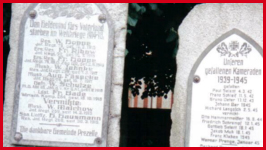The Inner German Border (ING) or 'anti-fascist protection barrier' separated the two Germany's and was the pride & joy of the MfS.
It ran for 800 miles, from just beyond Lubeck in the North to the border with what is now the Czech Republic in the South. 800 were killed attempting to cross it. The immediate border zone was five kilometres deep; entry to it was prohibited to non-residents, another five-kilometre 'exclusion' zone preceded it. Family members of residents living in the border zone could apply for permission to visit. They were obliged to give six weeks' notice and, as a general rule, permission was only granted for serious illness or major anniversaries.
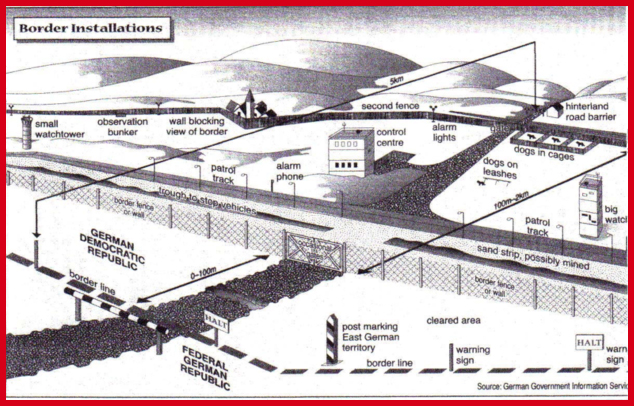 The Fence.
The Fence.
Or you may prefer the East German perspective below.
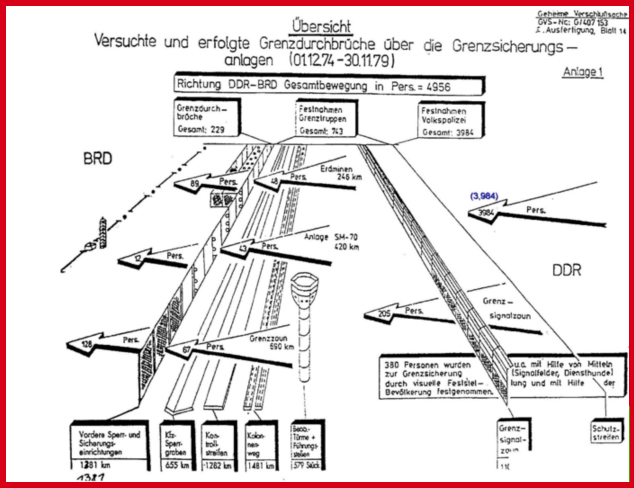 The Fence as seen from the other side
The Fence as seen from the other side
This secret map prepared by the East German Border Police in 1979 reports on the outcome of 4,956 known escape attempts. Of that number 3,984 (fig highlighted above) were apprehended prior to them reaching the innermost (or hinterland) border. 743 were caught in the kill zone. 229 made it to the West.
The task that would have been facing any attempted crosser was enormous. However it was one that Nato Special Forces were trained for. The principal European Nato infiltration school was (and still is) the International Long Range Reconnaissance Patrol School in Pfullendorf a small town near Lake Konstanz, the Bodenseee in Germany. Britain's SAS maintained a permanent presence in the school which was one of the very few accompanied posting the Regiment had. There, soldiers were familiarised with the terrain facing them in the East. In the event of war Nato special forces were expected to infiltrate for up to 250 miles behind enemy lines.
They had much to overcome. Some considerable distance from the actual border was the main fence, which was more substantial than the one visible from the West. Between the two 'fences' were mines, guard dogs on loose chains many metres long, surveillance towers, electronic devices, self-firing machine guns. There were intensive motorised patrols of the Grenzetruppe of the Nationalen Volksarmee and by the Grenzberietschaft of the Volkspolizie, (border troops and border police), who by regulation could never be more than a set number of minutes distant from any point in the fence. And there were other even more specialised units, such as the special forces trained Aufklarer. While the border control zone extended for five kilometres for five kilometres beyond that there was a heavily policed exclusion zone, entry into which was also controlled. It would have been in this zone that the 3,984 referred to above would have been caught.
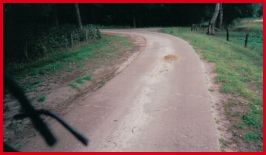 Patrol Track.
Patrol Track.
Photo © Paddy Hayes.
The tarmac road ran for the entire 800-mile length of the border. It was designed so that motorised patrols could both run regular patrols and also reach quickly any spot where intruders or potential escapees were spotted.
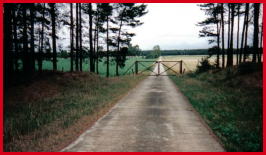 The 'Secret Gate' near Prezelle.
The 'Secret Gate' near Prezelle.
Photo © Paddy Hayes.
The DDR authorities used this gate to facilitate secret ingress and egress between the DDR and FRG. Users included HVA agents being inserted into the 'operational territory' and terrorists from the Red Army Faction (RAF) on much needed R&R. This despite constant denials by the East that they supported terrorism in the West.
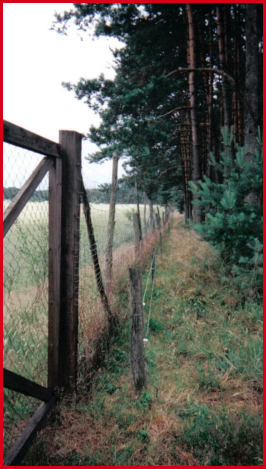 The Fence.
The Fence.
Photo © Paddy Hayes.
The quality of 'The Fence' varied according to circumstances. As a general rule the hinterland fence was the more robust of the two. Close to major Western population centres the border fence tended to be eight-foot walls.
 Border Guards billet.
Border Guards billet.
Photo © Paddy Hayes.
Small detachments of Border Guards were billeted in groups along the length of the border. This made for faster reaction times, enabled them to become familiar with their patch and with its inhabitants. 30 Border Guards lived in a wooded hut adjacent to this woodcutter's house in the Wirl close to the secret gate above. This detachment would have been instructed to 'remain –in-barracks' on nights when the gate was opened for clandestine crossings.
 Countryside to the East.
Countryside to the East.
Photo © Paddy Hayes.
The countryside to the East (part of the North German Plain) was flat. Finding secure lying-up-points (LUP's) to hideout during daylight hours was difficult. Border residents were severely punished for not reporting the presence of strangers in the border zone, which in any event was kept sparsely populated by design.
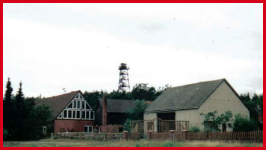 Watch Tower in Prezelle on the Western side of the border.
Watch Tower in Prezelle on the Western side of the border.
Photo © Paddy Hayes.
Towering over even the tallest trees, the West German ZGD – Zollgrendienst border patrol- erected this tower as a counter to the use of the secret gate and for general surveillance purposes. Quite a number were constructed for this purpose along the length of the border on its Western side. On the Western side there was also a border zone, the Zonengrenzbezirk, it too extended back about ten kilometres and was patrolled by the ZGD, and for a further thirty kilometres beyond there were armed patrols of the Bundesgrenschutz.
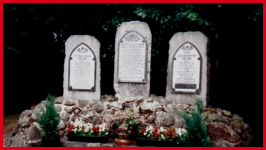 War Memorial in Prezelle.
War Memorial in Prezelle.
Photo © Paddy Hayes.
The tablet in the centre commemorates those who died in the First World War, the ones on either side those who perished in the Second. Three men with the family name Schulz perished in World War II, one Schulz in the First. Hard to imagine they weren't related in a small place like Prezelle.
